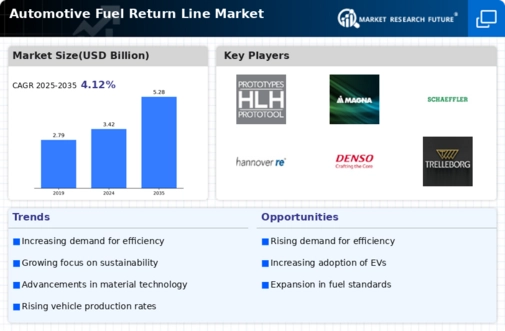Market Trends and Projections
The Global Automotive Fuel Return Line Market Industry is characterized by various trends and projections that indicate its future trajectory. The market is expected to grow from 3.42 USD Billion in 2024 to 5.28 USD Billion by 2035, with a CAGR of 4.03% from 2025 to 2035. These figures suggest a steady increase in demand for fuel return line systems, driven by technological advancements, regulatory compliance, and the rise of fuel-efficient vehicles. The market dynamics are likely to evolve as manufacturers respond to consumer preferences and environmental concerns, shaping the future landscape of the automotive fuel return line industry.
Growing Demand for Fuel-Efficient Vehicles
The Global Automotive Fuel Return Line Market Industry is experiencing a surge in demand for fuel-efficient vehicles. As consumers become increasingly environmentally conscious, manufacturers are compelled to innovate and enhance fuel efficiency. This trend is reflected in the projected market size of 3.42 USD Billion in 2024, indicating a robust growth trajectory. Automakers are integrating advanced fuel return line systems to optimize fuel delivery and minimize waste, thereby improving overall vehicle performance. The emphasis on sustainability is likely to drive further investments in technology and infrastructure, ensuring that the market remains dynamic and responsive to consumer preferences.
Technological Advancements in Fuel Systems
Technological advancements play a pivotal role in shaping the Global Automotive Fuel Return Line Market Industry. Innovations such as electronic fuel injection systems and advanced materials for fuel lines are enhancing the efficiency and reliability of fuel return lines. These developments not only improve vehicle performance but also contribute to reduced emissions. As manufacturers adopt cutting-edge technologies, the market is expected to grow significantly, with a projected CAGR of 4.03% from 2025 to 2035. This growth is indicative of the industry's commitment to integrating technology that meets regulatory standards while satisfying consumer demands for high-performance vehicles.
Increase in Automotive Production and Sales
The Global Automotive Fuel Return Line Market Industry is poised for growth due to the increase in automotive production and sales. As global economies recover and consumer confidence rises, the demand for new vehicles is expected to escalate. This uptick in production directly correlates with the need for efficient fuel return line systems, which are essential for optimizing fuel delivery in modern vehicles. The market is projected to reach 5.28 USD Billion by 2035, reflecting the industry's response to rising consumer demand. Consequently, manufacturers are likely to enhance their production capabilities to meet this growing need, further driving market expansion.
Regulatory Compliance and Emission Standards
The Global Automotive Fuel Return Line Market Industry is heavily influenced by stringent regulatory compliance and emission standards. Governments worldwide are implementing policies aimed at reducing vehicular emissions, which necessitates the adoption of advanced fuel return line technologies. Compliance with these regulations often requires manufacturers to invest in new systems that enhance fuel efficiency and reduce environmental impact. As a result, the market is likely to expand, driven by the need for innovative solutions that align with regulatory frameworks. This trend not only fosters technological advancement but also encourages collaboration among industry stakeholders to develop compliant systems.
Rising Popularity of Electric and Hybrid Vehicles
The Global Automotive Fuel Return Line Market Industry is also influenced by the rising popularity of electric and hybrid vehicles. Although these vehicles utilize different fuel systems, the integration of fuel return lines in hybrid models remains crucial for optimizing performance. As the market for hybrid vehicles expands, manufacturers are focusing on developing specialized fuel return line systems that cater to this segment. This shift indicates a diversification in the market, as companies adapt to changing consumer preferences and technological advancements. The growth of hybrid vehicles may lead to new opportunities for innovation within the fuel return line sector.





















Leave a Comment